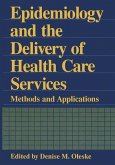A History of Epidemiologic Methods and Concepts is based on a collection of contributions which appeared in "SPM International Journal of Public Health", starting in January 2001. The contributions focus on the historical emergence of current epidemiological methods and their relative importance at different points in time, rather than on specific achievements of epidemiology in controlling plagues such as cholera, tuberculosis, malaria, typhoid fever, or lung cancer. The papers present the design of prospective and retrospective studies, and the concepts of bias, confounding, and interaction. The compilation of articles is complemented by an introduction and comments by Prof. Alfredo Morabia which puts them in the context of current epidemiological research.
Dieser Download kann aus rechtlichen Gründen nur mit Rechnungsadresse in A, B, BG, CY, CZ, D, DK, EW, E, FIN, F, GR, HR, H, IRL, I, LT, L, LR, M, NL, PL, P, R, S, SLO, SK ausgeliefert werden.
"Morabia's approach is didactic, combining historical snippets with lessons on epidemiology. (American Journal of Epidemiology
...one of those few books whose reading is 'pleasantly unavoidable'... Very likely to become one of the most important epidemiological books published in the present decade." -- European Epidemiology Federation
"Morabia's approach is not only highly educational, but also a gripping read and should fascinate everybody who is concerned with epidemiology, public health, or history of medicine. Furthermore, this book will certainly be inevitable for teachers and students of public health since it offers a great variety of educational material for courses in medicine and epidemiology. Taken together, this book is highly valuable and will hopefully soon become a modern classic." -- Biometrics
Morabia's approach is didactic, combining historical snippets with lessons on epidemiology. (American Journal of Epidemiology)
...one of those few books whose reading is 'pleasantly unavoidable'... Very likely to become one of the most important epidemiological books published in the present decade. (European Epidemiology Federation)
Morabia's approach is not only highly educational, but also a gripping read and should fascinate everybody who is concerned with epidemiology, public health, or history of medicine. Furthermore, this book will certainly be inevitable for teachers and students of public health since it offers a great variety of educational material for courses in medicine and epidemiology. Taken together, this book is highly valuable and will hopefully soon become a modern classic. (Biometrics)









